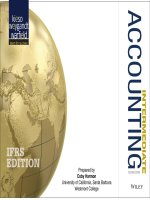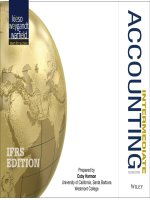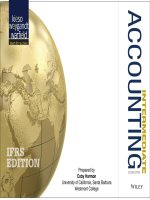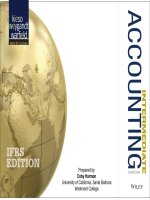Lecture Intermediate accounting (IFRS 2nd edition): Chapter 10 - Kieso, Weygandt, Warfield
Bạn đang xem bản rút gọn của tài liệu. Xem và tải ngay bản đầy đủ của tài liệu tại đây (1.4 MB, 65 trang )
10-1
PREVIEW OF CHAPTER
10
Intermediate Accounting
IFRS 2nd Edition
Kieso, Weygandt, and Warfield
10-2
10
Acquisition and Disposition
of Property, Plant, and
Equipment
LEARNING OBJECTIVES
After studying this chapter, you should be able to:
1. Describe property, plant, and
equipment.
5. Understand accounting issues related
to acquiring and valuing plant assets.
2. Identify the costs to include in initial
valuation of property, plant, and
equipment.
6. Describe the accounting treatment for
costs subsequent to acquisition.
3. Describe the accounting problems
associated with selfconstructed assets.
4. Describe the accounting problems
associated with interest capitalization.
10-3
7. Describe the accounting treatment for
the disposal of property, plant, and
equipment.
PROPERTY, PLANT, AND EQUIPMENT
Property, plant, and equipment are assets of a durable
nature. Other terms commonly used are plant assets and
fixed assets.
►“Used in operations” and not for
resale.
Includes:
§
Land,
§
Building structures
(offices, factories,
►Longterm in nature and usually
depreciated.
►Possess physical substance.
10-4
warehouses), and
§
Equipment
(machinery, furniture,
tools).
LO 1
10
Acquisition and Disposition
of Property, Plant, and
Equipment
LEARNING OBJECTIVES
After studying this chapter, you should be able to:
1. Describe property, plant, and
equipment.
5. Understand accounting issues related
to acquiring and valuing plant assets.
2. Identify the costs to include in
initial valuation of property,
plant, and equipment.
6. Describe the accounting treatment for
costs subsequent to acquisition.
3. Describe the accounting problems
associated with selfconstructed assets.
4. Describe the accounting problems
associated with interest capitalization.
10-5
7. Describe the accounting treatment for
the disposal of property, plant, and
equipment.
ACQUISITION OF PROPERTY, PLANT,
AND EQUIPMENT (PP&E)
Historical cost measures the cash or cash equivalent price of
obtaining the asset and bringing it to the location and condition
necessary for its intended use.
In general, costs include:
1.Purchase price, including import duties and nonrefundable
purchase taxes, less trade discounts and rebates.
2.Costs attributable to bringing the asset to the location and
condition necessary for it to be used in a manner
intended by the company.
10-6
LO 2
ACQUISITION OF PROPERTY, PLANT,
AND EQUIPMENT (PP&E)
Companies value property, plant, and equipment in
subsequent periods using either the
ucost method or
ufair value (revaluation) method.
10-7
LO 2
ACQUISITION OF PP&E
Cost of Land
All expenditures made to acquire land and ready it for use.
Costs typically include:
(1)
(2)
(3)
(4)
(5)
10-8
purchase price;
closing costs, such as title to the land, attorney’s fees, and
recording fees;
costs of grading, filling, draining, and clearing;
assumption of any liens, mortgages, or encumbrances on
the property; and
additional land improvements that have an indefinite life.
LO 2
ACQUISITION OF PP&E
Cost of Land
uImprovements with limited lives, such as private
driveways, walks, fences, and parking lots, are
recorded as Land Improvements and depreciated.
uLand acquired and held for speculation is classified as
an investment.
uLand held by a real estate concern for resale should be
classified as inventory.
10-9
LO 2
ACQUISITION OF PP&E
Cost of Buildings
Includes all expenditures related directly to acquisition or
construction. Costs include:
umaterials, labor, and overhead costs incurred during
construction and
uprofessional fees and building permits.
Companies consider all costs incurred, from excavation to
completion, as part of the building costs.
10-10
LO 2
ACQUISITION OF PP&E
Cost of Equipment
Include all expenditures incurred in acquiring the equipment
and preparing it for use. Costs include:
upurchase price,
ufreight and handling charges,
uinsurance on the equipment while in transit,
ucost of special foundations if required,
uassembling and installation costs, and
ucosts of conducting trial runs.
10-11
LO 2
ACQUISITION OF PP&E
Illustration: The expenditures and receipts below are related to land,
land improvements, and buildings acquired for use in a business
enterprise. Determine how the following should be classified:
a.
Money borrowed to pay building contractor
(signed a note)
a.
Notes Payable
b.
Payment for construction from note proceeds
b.
Buildings
c.
Cost of land fill and clearing
c.
Land
Delinquent real estate taxes on property
assumed by purchaser
d.
Land
Premium on 6month insurance policy during
construction
e.
Buildings
d.
e.
10-12
LO 2
ACQUISITION OF PP&E
Illustration: Determine how the following should be classified:
f.
g.
h.
Refund of 1month insurance premium
because construction completed early
Architect’s fee on building
Cost of real estate purchased as a plant site
(land €200,000 and building €50,000)
i.
Commission fee paid to real estate agency
j.
Cost of razing and removing building
k.
Installation of fences around property
10-13
f.
(Buildings)
g.
Buildings
h.
Land
i.
Land
j.
Land
k.
Land
Improvements
LO 2
ACQUISITION OF PP&E
Illustration: Determine how the following should be classified:
l.
m.
n.
o.
p.
10-14
Proceeds from residual value of demolished
building
Interest paid during construction on money
borrowed for construction
Cost of parking lots and driveways
Cost of trees and shrubbery planted
(permanent in nature)
Excavation costs for new building
l.
(Land)
m.
Buildings
o.
Land
Improvements
Land
p.
Buildings
n.
LO 2
10
Acquisition and Disposition
of Property, Plant, and
Equipment
LEARNING OBJECTIVES
After studying this chapter, you should be able to:
1. Describe property, plant, and
equipment.
5. Understand accounting issues related
to acquiring and valuing plant assets.
2. Identify the costs to include in initial
valuation of property, plant, and
equipment.
6. Describe the accounting treatment for
costs subsequent to acquisition.
3. Describe the accounting
problems associated with self
constructed assets.
4. Describe the accounting problems
associated with interest capitalization.
10-15
7. Describe the accounting treatment for
the disposal of property, plant, and
equipment.
ACQUISITION OF PP&E
SelfConstructed Assets
Costs include:
u
Materials and direct labor
u
Overhead can be handled in two ways:
1.
2.
Assign no fixed overhead.
Assign a portion of all overhead to the construction
process.
Companies use the second method extensively.
10-16
LO 3
10
Acquisition and Disposition
of Property, Plant, and
Equipment
LEARNING OBJECTIVES
After studying this chapter, you should be able to:
1. Describe property, plant, and
equipment.
5. Understand accounting issues related
to acquiring and valuing plant assets.
2. Identify the costs to include in initial
valuation of property, plant, and
equipment.
6. Describe the accounting treatment for
costs subsequent to acquisition.
3. Describe the accounting problems
associated with selfconstructed assets.
4. Describe the accounting
problems associated with
interest capitalization.
10-17
7. Describe the accounting treatment for
the disposal of property, plant, and
equipment.
ACQUISITION OF PP&E
Interest Costs During Construction
Three approaches have been suggested to account for the
interest incurred in financing the construction.
$ 0
Capitalize no
interest during
construction
ILLUSTRATION 101
Capitalization of Interest
Costs
10-18
Increase to Cost of Asset
Capitalize actual
costs incurred during
construction
$ ?
Capitalize
all costs of
funds
IFRS
LO 4
ACQUISITION OF PP&E
Interest Costs During Construction
uIFRS requires — capitalizing actual interest (with
modification).
uConsistent with historical cost.
uCapitalization considers three items:
10-19
1.
Qualifying assets.
2.
Capitalization period.
3.
Amount to capitalize.
LO 4
Interest Costs During Construction
Qualifying Assets
Require a substantial period of time to get them ready for
their intended use or sale.
Two types of assets:
uAssets under construction for a company’s own use.
uAssets intended for sale or lease that are constructed or
produced as discrete projects.
10-20
LO 4
Interest Costs During Construction
Capitalization Period
Begins when:
1. Expenditures for the assets are being incurred.
2. Activities for readying the asset for use or sale are
in progress .
3. Interest costs are being incurred.
Ends when:
The asset is substantially complete and ready for use.
10-21
LO 4
Interest Costs During Construction
Amount to Capitalize
Capitalize the lesser of:
1. Actual interest cost incurred.
2. Avoidable interest the amount of interest cost during
the period that a company could theoretically avoid if it
had not made expenditures for the asset.
10-22
LO 4
Interest Costs During Construction
Illustration: Assume a company borrowed $200,000 at 12% interest
from State Bank on Jan. 1, 2015, for specific purposes of constructing
specialpurpose equipment to be used in its operations. Construction on
the equipment began on Jan. 1, 2015, and the following expenditures were
made prior to the project’s completion on Dec. 31, 2015:
Actual Expenditures during 2015:
January 1
April 30
150,000
November 1
300,000
December 31
100,000
Total expenditures
10-23
$ 100,000
$ 650,000
Other general debt existing on
Jan. 1, 2015:
$500,000, 14%, 10year
bonds payable
$300,000, 10%, 5year
note payable
LO 4
Interest Costs During Construction
Step 1 Determine which assets qualify for capitalization of
interest.
Special purpose equipment qualifies because it requires a period of
time to get ready and it will be used in the company’s operations.
Step 2 Determine the capitalization period.
The capitalization period is from Jan. 1, 2015 through Dec. 31, 2015,
because expenditures are being made and interest costs are being
incurred during this period while construction is taking place.
10-24
LO 4
Interest Costs During Construction
Step 3 Compute weightedaverage accumulated
expenditures.
Date
Jan. 1
Apr. 30
Nov. 1
Dec. 31
Weighted
Average
Actual
Capitalization Accumulated
Expenditures
Period
Expenditures
$ 100,000
12/12
$ 100,000
150,000
8/12
100,000
300,000
2/12
50,000
100,000
0/12
$ 650,000
$ 250,000
A company weights the construction expenditures by the amount of time
(fraction of a year or accounting period) that it can incur interest cost on the
expenditure.
10-25
LO 4









